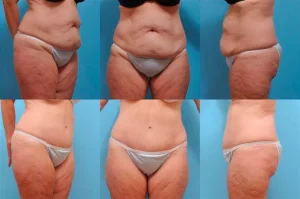Facelift 101
No two faces are exactly the same — even the most identical twins will have very slight variations in their features. This means that when choosing a facelift, there is no ”one size fits all” option.
Each person has unique features, whether it’s your bone structure, skin thickness, or the amount of soft tissue your face has. These features determine the type of facelift you should opt for. Your choice also hinges on a timeline and how much downtime you have at your disposal.
Want to learn more about the various types of facelifts? This blog is for you!
1. A Deep Plane Facelift
Also known as a SMAS facelift which stands for the superficial musculoaponeurotic system, this is one of the most popular facelift versions today.
A deep plane facelift focuses on the chin and neck area and intends to lift the skin around the base of the face. Essentially, the aim is to create more definition in the jawline and eliminate the look of sagging skin.
A SMAS facelift tightens the muscles around the chin and neck, which, in turn, tightens the skin in those regions. Your plastic surgeon delves into the superficial musculoaponeurotic system and repositions the muscles to reshape the chin, neck, and jawline.
2. A Mini Facelift
This popular variation is also called a short scar facelift. As the name suggests, this procedure leaves minimal scars that your surgeon hides in your hairline.
A mini facelift aims to lift the skin of the face by making small incisions in the hairline and tightening any areas of loose skin. Your surgeon will also remove excess skin where necessary.
This type of facelift is ideal if you have small areas of concern you’d like corrected, such as minor jowls. But remember that a mini facelift won’t address any concerns around the neck.
3. A Midsection Facelift
More commonly known as a mid-facelift, this procedure concentrates on the middle or midsection of the face. This is the best facelift option if you want excess skin or tissue removed from your cheek area. Or, your surgeon can stitch up and use this excess skin to lift your cheeks.
Bear in mind that a midsection facelift won’t necessarily add volume or plumpness back into your cheeks. But it can eliminate the look of sagging skin and create a tighter, smoother, and more youthful appearance.
This type of facelift is also recommended if you want to decrease the depth of your nasolabial folds — the lines just below your cheeks and above the mouth.

4. A Skin-Only Facelift
While this facelift does not offer the longevity of a SMAS facelift, it’s still an excellent option for smoothing out wrinkles in most areas of the face. The skin-only facelift begins with small incisions made just behind the ears. An s-shaped incision follows behind the jawline and around the neck.
These incisions allow your surgeon to separate your epidermis (top layer of skin) from the muscles and tissue underneath. They can then lift and reposition the skin as needed and remove any excess where necessary. Your surgeon can also contour the muscles and tissue underneath.
5. A Temporal Lift
Also dubbed an upper facelift, this is the best for smoothing out and tightening the skin of the brow and eye area, i.e., the upper face. Naturally, your brows and temples are pretty close together, so this facelift benefits more than one area of the face in just one procedure.
For example, if you have drooping eyebrows and deep forehead wrinkles, the temporal lift can solve both concerns in one go. Basically, your surgeon makes a small incision in your hairline and lifts the skin and muscles to tighten the skin of the upper face.
6. Rejuvenation of the Jawline
As the name suggests, this is the best facelift treatment option if you have jowls and want to tighten the skin around the jaw and neck.
This procedure involves liposuction around the neck area to remove excess fat cells. Your surgeon will then contour the skin and muscles to make everything look tighter and smoother.
7. A Liquid Facelift
Of course, there’s also the option of a non-invasive facelift that does not involve surgery. If you’re interested in tightening and plumping the skin without going under the knife, you have injectables to choose from.
Some popular neuromodulators include Botox, Dysport, and Jeaveau. In contrast, popular filler options include Juvederm and Restylane. However, a liquid facelift is often a temporary option and will only smooth out the skin for a few months.
Choosing a Facelift Surgeon
Deciding to undergo a surgical procedure like a facelift is a big decision. While each procedure is safe, there are always risks involved.
The success and outcome of your facelift hinge on the surgeon you choose. While searching the internet, you may find many and become confused about who’s best and who to choose. We want to make your decision easier. Here we explain a bit about our plastic surgeons at The Plastic Surgery Group.
The Plastic Surgery Group has been providing plastic surgeries since 2006 in New York and New Jersey. Dr. Allen Rosen and Dr. Valerie Ablaza are renowned and board-certified plastic surgeons. The 15,000-square-foot facility offers a contemporary state-of-the-art facility with an on-site ambulatory surgery center.
Over the years, The Plastic Surgery Group has received media recognition across all media types and is known as an integrated model of business and professionalism. The referral list is extensive, as referrals come from within the medical community and all those who want to help others seeking the utmost of care.
Facelift 101: Making the Right Choice
Choosing the best surgeon with experience is key to loving the end result and feeling genuinely comfortable in your skin if you’re considering a facelift.
You have the best with the Plastic Surgery Group, featuring Dr. Allen Rosen and Dr. Valerie Ablaza. Make the right choice and get in touch with our plastic surgery center today to schedule an appointment to discuss your options. Our state-of-the-art facility is located in Montclair, NJ.




